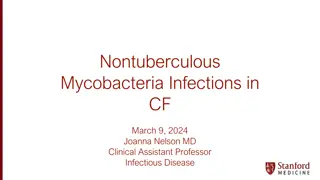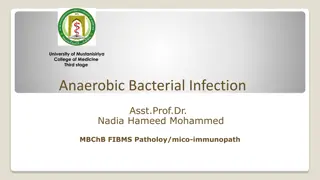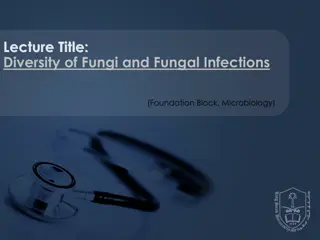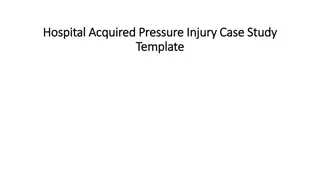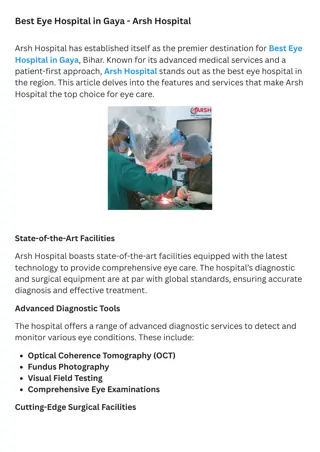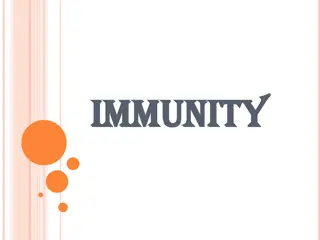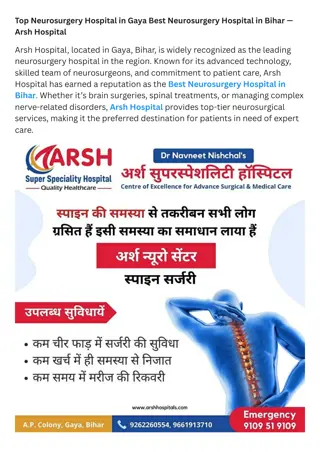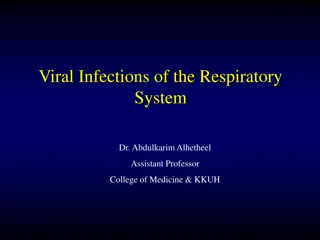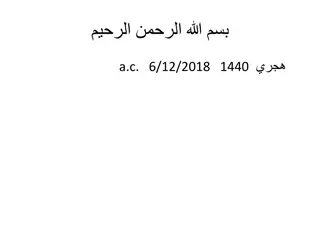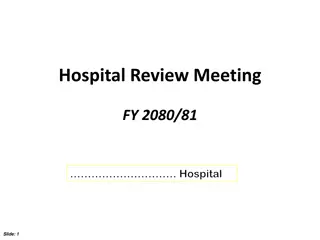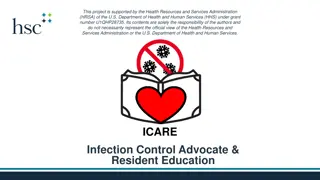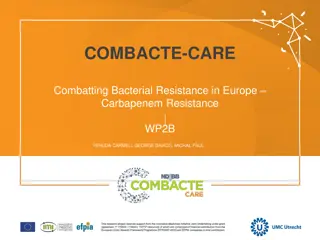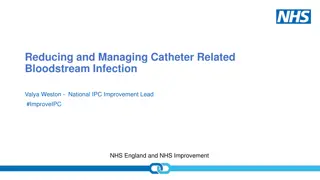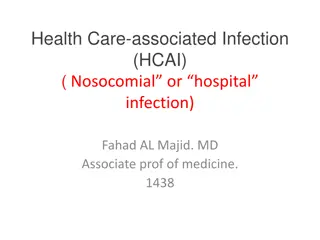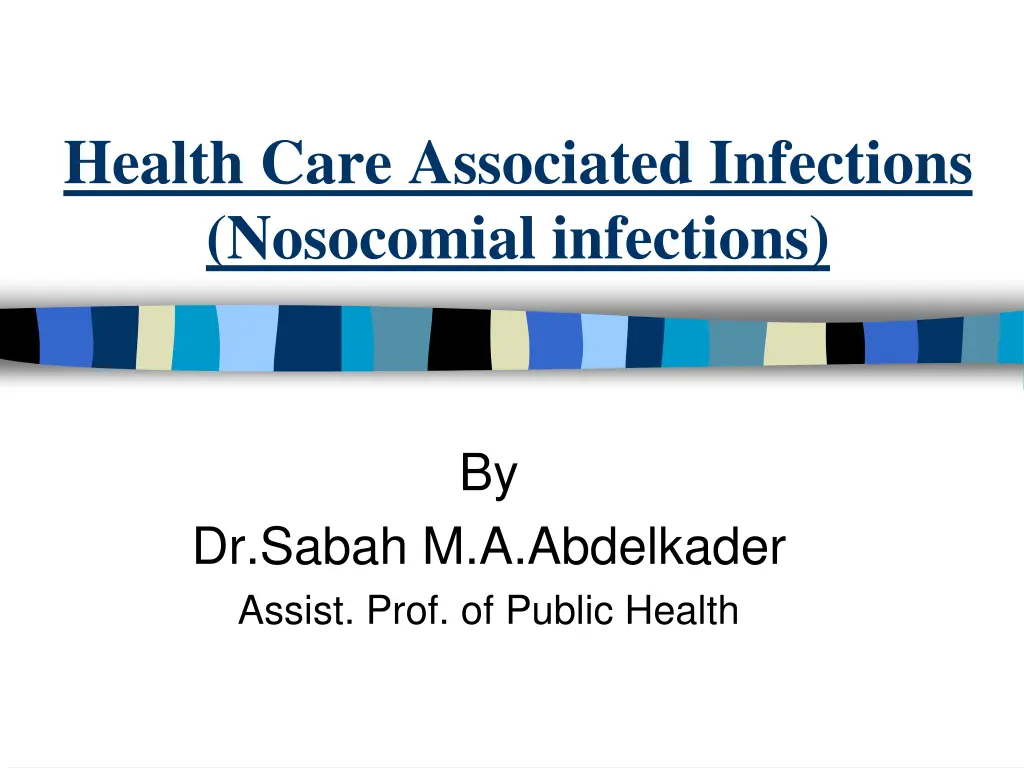
Understanding Nosocomial Infections: A Comprehensive Overview by Dr. Sabah M.A. Abdelkader
Gain insights into health care-associated infections, also known as nosocomial infections, in this informative lecture by Dr. Sabah M.A. Abdelkader. Explore the definition, categories, control methods, and descriptive epidemiology of NCIs. Understand the risk factors, common sites of infection, and effective control programs to tackle these infections effectively. Enhance your knowledge to improve quality healthcare delivery and patient safety.
Download Presentation

Please find below an Image/Link to download the presentation.
The content on the website is provided AS IS for your information and personal use only. It may not be sold, licensed, or shared on other websites without obtaining consent from the author. If you encounter any issues during the download, it is possible that the publisher has removed the file from their server.
You are allowed to download the files provided on this website for personal or commercial use, subject to the condition that they are used lawfully. All files are the property of their respective owners.
The content on the website is provided AS IS for your information and personal use only. It may not be sold, licensed, or shared on other websites without obtaining consent from the author.
E N D
Presentation Transcript
Health Care Associated Infections (Nosocomial infections) By Dr.Sabah M.A.Abdelkader Assist. Prof. of Public Health
Objectives By the end of this lecture, students should be able to: Define NCIs correctly. Recognize categories of NCIs. Discuss descriptive epidemiology of NCIs Identify components of NCIs control. Analyze effective control programs.
Introduction HAIs is cross infection of one patient by another or by doctors, nurses and other hospital staff while in hospital. A high frequency of NCIs is evidence of poor quality of health service delivery. Many factors contribute to frequency of NCIs. NCIs may be endemic or epidemic. Changes in health care delivery have resulted in shorter hospital stay and increased outpatient care.
Definition Care Associated (HAIs) or nosocomial infections (NCIs) are infections that acquired in patients during or associated with delivery of health care which are not present at admission. Infections occurring more than 48 hours after admission are considered NCIs. Health Infections
Categories of HAIs Certain sites are particularly common: 1-Urinary Tract Infections: The most common infection (30%) of HAIs is mainly due to use of catheters. 2-Surgical Wound Infections: The second most common HAIs.
Cont. 3-Lower Respiratory Infections: Pneumonias are responsible for 15% of HAIs. The most common fatal HAIs( case fatality rate of about 30%). Endotracheal intubations is a risk factor for pneumonia. 4-Bloodstream Infections: It is the most common site of HAIs among neonates in high- risk nurseries. 5- Diseases transmitted through unscreened blood transfusion such as HIV, HBV, HCV, HDV, malaria and syphilis or parentrally
Descriptive Epidemiology. I Person II Place III - Time
I - Person 1- Age: Newborn babies and elderly are at a higher risk of HAIs. 2- Malnourished patients are more likely to acquire nosocomial infections. 3-Comorbidities:chronic debilitating diseases and severity of underlying diseases.
Cont. 4-Use of invasive procedures , potent immunosuppressive, chemotherapeutic agents. These drugs affect the host s normal colonizing flora, cause skin and mucous membrane breakdown and impair the function of the immune system. 5- Prolonged hospitalization. 6- Other personal characteristics : marital status, sex & socioeconomic status may reflect the type of hospital attended and the level of health care provided.
II - Place The frequency of HAIs differs between hospitals and even between different units within the same hospital. This difference is attributed to - The level of infection control program. - The nature of the procedure carried. - The characteristic and the type of patients attended.
Cont. Examples: The frequency of HAIs is higher in the secondary health care facilities than that in the primary health care ones. The frequency of the HAIs is greater in intensive care units (ICU) burn units, urology units than that in the other units.
III - Time Outbreaks particularly those related to parenteral injection and surgery if medical staffs are not adequately trained. of HAIs may occur
Sources of infection I Patients. II Staff. III Environment.
I - Patients Viral infections e.g measles, influenza. Skin infections e.g. discharging wounds. Respiratory infections e.g pneumonia. Urinary tract infection e.g B coli infection.
II - Staff Doctors, nurses, ward boys who come in close contact with patients. Staph aureus carried in nose or skin. Hemolytic strept carried in the throat. Salmonella carried in GIT.
III - Environment Hospital environment (through hospital dust, linen, bed clothes, furniture, basins, door handles) microorganisms forming an important source of infection. is laden with
Routes of infection Direct contact from hands of a nurse or doctor to a susceptible patient. Droplet infection through cough or sneezing. Air-borne infection e.g TB Release of hospital dust into the air. Various hospital procedures e.g IV, catheters, infected cat gut, dressings, bed pans, sputum cups.
Recipients All patients in hospitals are potential recipients. Some are more susceptible than others. NCIs are more geriatric wards and special baby care units. in ICU, urological,
Components of effective health care associated Infections control Program. I- Surveillance. II-Control Measures. III-Available qualified well trained personnel: A- Infection Control Practitioner. b- Hospital Epidemiologist.
I-Surveillance It should be conducted prospectively before patients are discharged. Data collected during surveillance of HAIs are: 1- Infection rates by site, pathogen, specialty service and patient care area, surgeon-specific wound infection rates, and procedure-specific rates should be calculated monthly and reported to hospital staff.
Cont. 2-Data related to the practices provided to the patients implementation of measures (Such as aseptic technique during invasive procedures) 3- Data related practices that control the microbiological agents such as disinfection procedures. to infection ensure the control to environmental sterilization and
II-Control Measures 1- Isolation: infectious patients must be isolated. Patients susceptible to infection should not be placed near source of infection. 2- Hospital staff diseases, sore throat, common cold, ear infection, diarrhea, dysentery should be kept away from work until complete cure. suffering from skin
Cont. 3-Hand touching blood, secretions, excretions and contaminated removing gloves. Use plain soap for routine hand washing and antimicrobial agent for specific circumstances. 4-Personal protective (PPE).These include shields and eye protection and are used whenever there is a risk of exposure to blood or other infective material. hygiene: Wash hand after articles and after equipment splash gloves,
Cont. 5-Aseptic techniques: Surgical scrub and gloving, sterile field and using good surgical technique. 6-Reprocessing of used instruments and sterile devices: Ensure that reusable equipment is not used for the care of another patient until it has been cleaned and reprocessed properly.
Cont. 7- Environmental cleaning: Cleaning and disinfection of environmental should be routinely done. 8- Proper sharps and waste disposal: Take care to prevent injuries when using needles, scalpels instruments and devices. surfaces and other sharp
III-Available qualified well trained personnel A-Infection control practitioner: At least one full-time infection control practitioner (ICP) for every 250 hospital beds is required. The main duties of ICP are: -Collecting and analyzing surveillance data. -Assisting in development of IC procedures. -Education and consultation to other staff.
B-Hospital epidemiologist: -Supervises the IC practitioners. -Provides liaison with other members of medical staff. -Provides advice about surveillance. -Conducting epidemiologic studies required investigating outbreaks of HAI. -Development of infection control measures.
Routine precautions Health workers are at risk of acquiring infection through occupational exposure. Employee s health should be reviewed at recruitment: immunization, exposure, serological hepatitis A-B-C, TB. previous AIDS, tests:
Thank you Thank you

